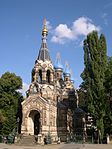Saxon State and University Library Dresden

The Saxon State and University Library Dresden (full name in German: Sächsische Landesbibliothek – Staats- und Universitätsbibliothek Dresden), abbreviated SLUB Dresden, is located in Dresden, Germany. It is both the regional library (German: Landesbibliothek) for the German State of Saxony as well as the academic library for the Dresden University of Technology (German: Technische Universität Dresden). It was created in 1996 through the merger of the Saxon State Library (SLB) and the University Library Dresden (UB). The seemingly redundant name is to show that the library brings both these institutional traditions together.The SLUB moved into a large new building in 2002 to bring together the inventories of both its predecessors. Its collection numbers nearly nine million, making it one of the largest public archival centers in the Federal Republic of Germany. It holds significant treasures, including the Codex Dresdensis, an octagonal Koran from 1184 and a copy of the Peter Schoeffer Bible printed in 1462. Within the SLUB is the Deutsche Fotothek, holding some 4 million photographs from the past 80 years, and the German Stenographic Institute.
Excerpt from the Wikipedia article Saxon State and University Library Dresden (License: CC BY-SA 3.0, Authors, Images).Saxon State and University Library Dresden
Dresden
Geographical coordinates (GPS) Address Website Nearby Places Show on map
Geographical coordinates (GPS)
| Latitude | Longitude |
|---|---|
| N 51.028055555556 ° | E 13.736666666667 ° |
Address
Technische Universität Dresden
01069 Dresden (Plauen)
Saxony, Germany
Open on Google Maps






